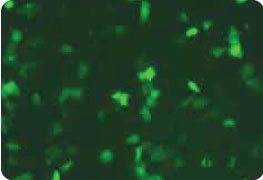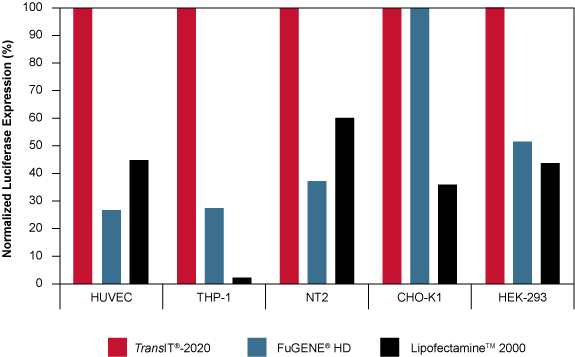TransIT®-2020 Transfection Reagent – 0.4 mL
A high performance, animal-free, broad spectrum DNA transfection reagent
$275.00
Description
- Broad Spectrum DNA Delivery – Achieve high expression in many cell types, including hard to transfect cell lines and primary cells
- Gentle to Your Cells – Balances high efficiency nucleic acid delivery and low cellular toxicity Learn more>>
- Animal Origin Free – High performance with maximum compatibility
SKU: MIR 5404
Supporting Data

TransIT®-2020 Reagent Exhibits Higher Expression and Lower Cellular Toxicity Compared to Other Transfection Reagents. Human umbilical vein endothelial cells (HUVEC) were transfected with a luciferase expression plasmid using the designated reagents at the reagent-to-DNA ratios indicated beneath each bar. Transfections were performed in 96-well plates using 0.1 µg of plasmid DNA per well. Luciferase expression (bar graph) and lactate dehydrogenase (LDH) levels (line graph) were measured at 24 hours post-transfection. LDH levels are reported as % cytotoxicity compared to cells alone and were measured using a commercially available colorimetric assay; all values at or below zero are represented as zero on graph. Error bars represent the standard deviation of triplicate wells.

High Performance Plasmid Transfection. Primary Human Small Epithelial Cells (HSAEpic) were transfected using TransIT®-2020 and an EGFP expression plasmid (4:1 reagent-to-DNA ratio). Images were taken 24 hours post-transfection using a Zeiss axiovert inverted fluorescence microscope.

Superior Gene Expression in a Broad Spectrum of Cell Types. The indicated cell types were transfected in 96-well plates with a luciferase expression plasmid (0.1 µg/well) according to industry accepted testing protocols. Reagent to DNA ratios were optimized for each cell type: TransIT®-2020 (Mirus Bio, 2:1 or 3:1), FuGENE® HD (Roche, 3.5:1), Lipofectamine® 2000 (Life Technologies, 1.5:1, 3:1 or 5:1). Luciferase activity was measured 24 hours post-transfection. Values were normalized to TransIT®-2020 and presented as a percentage of luciferase expression. FuGENE® is a registered trademark of Fugent LLC. Lipofectamine® is a trademark of Life Technologies Corporation.
Resources
Specifications
Storage Conditions
All Configurations: Store at -20°C
Product Guarantee
All Configurations: 1 year
Usage Statement
All Configurations: For Research Use Only.
Animal Origin Statement
All Configurations: This product is animal origin free.
Technical Product Literature
Full Protocol
TransIT®-2020 Full Transfection Protocol (PDF)
Quick Reference Protocols
TransIT®-2020 Quick Ref Protocol (PDF)
Optimization Protocol
Optimization Protocol for DNA Transfection (PDF)
Additional Information
Why compromise your transfection results with toxicity?
Cell types successfully transfected using TransIT®-2020: Cell lines (PDF) | Primary or stem cells (PDF)
FAQs
See the TransIT-2020 FAQs
Using transfection reagents and enhancers from Mirus has given our platform a competitive advantage. Increasing efficiency and lowering costs for all of our programs.
Sally Mader, PhD
ZYZ Theraputics





